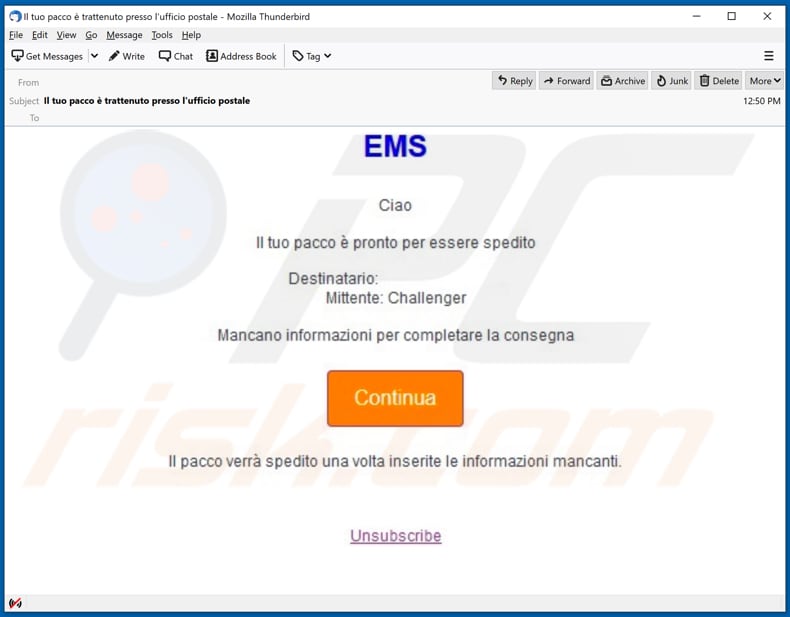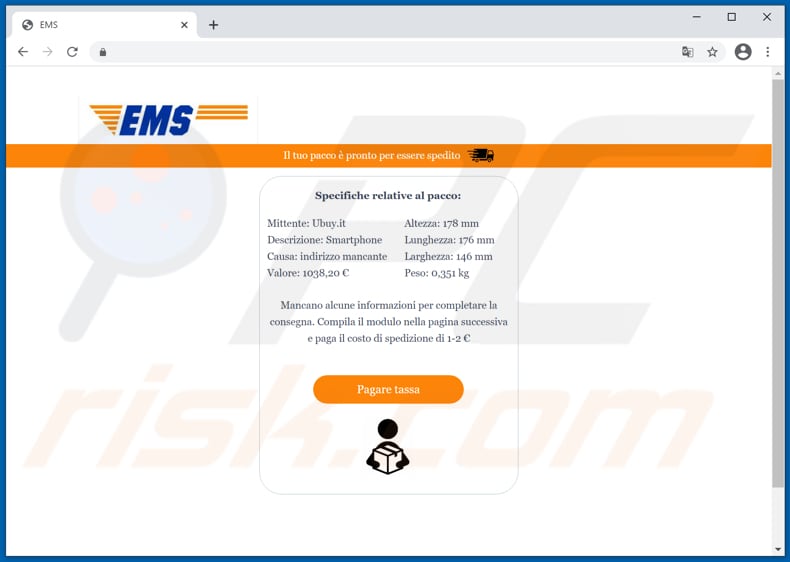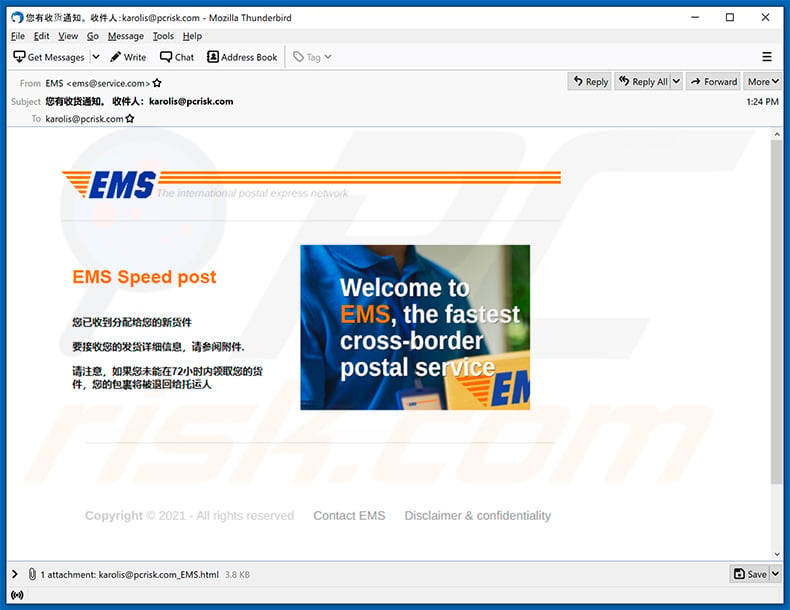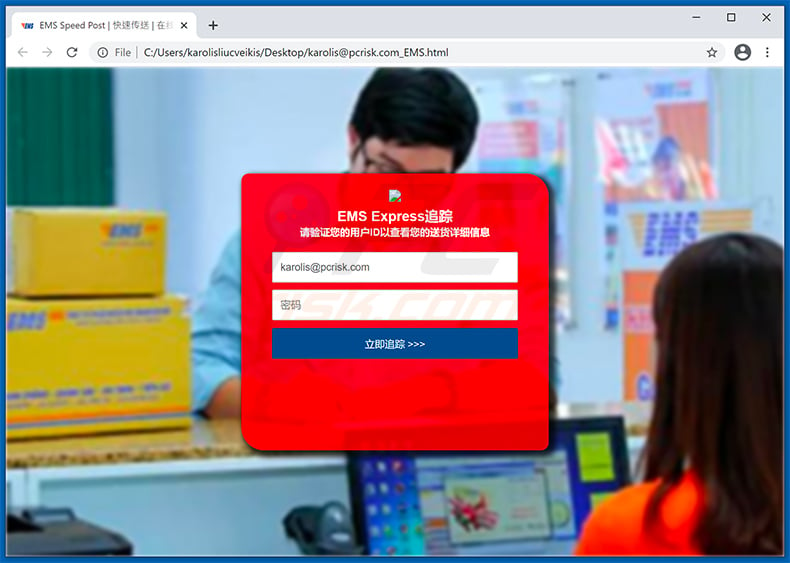Do not enter details on the website provided in the EMS email scam
Phishing/ScamAlso Known As: EMS spam
Get free scan and check if your device is infected.
Remove it nowTo use full-featured product, you have to purchase a license for Combo Cleaner. Seven days free trial available. Combo Cleaner is owned and operated by RCS LT, the parent company of PCRisk.com.
What is "EMS" email scam?
Scammers behind email phishing campaigns like this one attempt to trick unsuspecting recipients into providing personal information such bank account numbers, passwords, usernames (log-in credentials), credit card details, social security numbers, or other sensitive information.
Also, they often try to trick recipients into transferring them money (e.g., paying "transaction", "processing" or other fees). It is noteworthy that most of the times they disguise their emails as letters from legitimate companies.
This email is disguised as a notification about the shipment delivery from EMS (Express Mail Service). It is written in the Italian language. Although, it is likely that there are other variants of this email written in other languages.

"EMS" email scam overview
EMS is a legitimate international mail service provider. Scammers behind this email disguised their letter as an email regarding a package that is ready to be shipped but cannot be until missing information is provided. The main purpose of this email scam is to trick recipients into clicking the "Continua" button, which opens a fake "EMS" website and following the provided instructions.
The website contains information about a fake package (its measurements, value, weight, sender, etc.) and claims that some information is missing to complete the delivery. It encourages to fill out the form on the next page (which is supposed to be opened after clicking the "Pagare tassa" button) and pay the shipping cost (from one to two euros).
As mentioned in the introduction, most scammers behind emails like this attempt to trick recipients into providing sensitive information. It seems that scammers behind this particular phishing campaign attempt to trick them into providing information and transferring money.
Their main goal likely is to extract details such as credit card details and definitely to get paid €1-2 for "shipping." No details should ever be provided on fake websites, especially when those pages ask to provide details like this fake "EMS" website is likely to be asking (credit card details, bank account number, possibly a CVV number, cardholder name, etc.).
Such information may be misused to steal identities, make unauthorized transactions, purchases, sold on the dark web (to other cyber criminals), and for other malicious purposes. Therefore, recipients who fall for such scams risk to become victims of identity theft, lose money, and encounter other issues.
| Name | EMS Email Scam |
| Threat Type | Phishing, Scam, Social Engineering, Fraud |
| Fake Claim | Shipment cannot be sent because some information is missing to complete the delivery |
| Disguise | Email from EMS (Express Mail Service) |
| Related Domain | pingtransport[.]com |
| Detection Names (pingtransport[.]com) | ESET (Phishing), Forinet (Phishing), Spamhaus (Spam), Full List (VirusTotal) |
| Symptoms | Unauthorized online purchases, changed online account passwords, identity theft, illegal access of the computer. |
| Distribution methods | Deceptive emails, rogue online pop-up ads, search engine poisoning techniques, misspelled domains. |
| Damage | Loss of sensitive private information, monetary loss, identity theft. |
| Malware Removal (Windows) |
To eliminate possible malware infections, scan your computer with legitimate antivirus software. Our security researchers recommend using Combo Cleaner. Download Combo CleanerTo use full-featured product, you have to purchase a license for Combo Cleaner. 7 days free trial available. Combo Cleaner is owned and operated by RCS LT, the parent company of PCRisk.com. |
Phishing spam campaign examples
More examples of email campaigns used with the purpose to trick recipients into providing personal information are "AlWasail Industrial Company Email Scam", "Debt Settlement Email Scam", "Monthly Email Validation Email Scam". It is important to mention that email can be used as a channel to distribute malicious software too.
Some examples of malware that cyber criminals are distributing via email are Agent Tesla, TrickBot, and LokiBot. As a rule, emails used to distribute malware are disguised as important letters from legitimate companies, organizations, or other entities as well.
How do spam campaigns infect computers?
Email that is used to deliver malware is called malspam. Typically, such email contains a malicious attachment or a malicious website (download page for a malicious file). Some examples of files that most cyber criminals use to deliver malware via email of this type are Microsoft Office documents, JavaScript files, executable files (e.g., EXE), PDF documents, archive files (e.g., ZIP, RAR). In most cases, users infect their computers after executing a malicious file.
It is important to mention that when a malicious document is opened with Microsoft Office 2010 or newer, it displays a notification saying that some active content has been disabled and does not install malware unless users enable content or editing (macros commands).
However, this does not apply to malicious documents opened with older MS Office versions - they do not have the "Protected View" mode that prevents malicious documents from installing malware right after they are opened.
How to avoid installation of malware?
Software, files downloaded from unofficial pages, via Peer-to-Peer networks (for example, torrent clients, eMule), third party downloaders, etc., should not be trusted. They should be downloaded from official, trustworthy websites and via direct links. It is important to mention that third-party installers cannot be trusted too.
Email attachments (and website links) in irrelevant emails sent from unknown, suspicious addresses should not be opened. It is common that emails of this kind are used to trick users into opening files designed to install malware on computers.
All installed software must be updated and activated with tools (or functions) that official software developers have designed. It is never safe to use third-party, unofficial tools for that.
Besides, it is not legal to activate licensed software with various 'cracking' tools (unofficial activation tools), or use pirated software. Also, a computer should be scanned for threats regularly.
It should be done with a reputable antivirus or anti-spyware software. If you've already opened malicious attachments, we recommend running a scan with Combo Cleaner Antivirus for Windows to automatically eliminate infiltrated malware.
Text presented in the "EMS" phishing email:
Subject: Il tuo pacco è trattenuto presso l'ufficio postale
EMS
Ciao
Il tuo pacco è pronto per essere spedito
Destinatario:
Mittente: ChallengerMancano informazioni per completare la consegna
Continua
Il pacco verrà spedito una volta inserite le informazioni mancanti.
Unsubscribe
Screenshot of the fake "EMS" website:

Another example of "EMS"-themed spam email promoting an HTML file used for phishing purposes:

Screenshot of the promoted HTML file:

Instant automatic malware removal:
Manual threat removal might be a lengthy and complicated process that requires advanced IT skills. Combo Cleaner is a professional automatic malware removal tool that is recommended to get rid of malware. Download it by clicking the button below:
DOWNLOAD Combo CleanerBy downloading any software listed on this website you agree to our Privacy Policy and Terms of Use. To use full-featured product, you have to purchase a license for Combo Cleaner. 7 days free trial available. Combo Cleaner is owned and operated by RCS LT, the parent company of PCRisk.com.
Quick menu:
- What is EMS spam?
- Types of malicious emails.
- How to spot a malicious email?
- What to do if you fell for an email scam?
Types of malicious emails:
![]() Phishing Emails
Phishing Emails
Most commonly, cybercriminals use deceptive emails to trick Internet users into giving away their sensitive private information, for example, login information for various online services, email accounts, or online banking information.
Such attacks are called phishing. In a phishing attack, cybercriminals usually send an email message with some popular service logo (for example, Microsoft, DHL, Amazon, Netflix), create urgency (wrong shipping address, expired password, etc.), and place a link which they hope their potential victims will click on.
After clicking the link presented in such email message, victims are redirected to a fake website that looks identical or extremely similar to the original one. Victims are then asked to enter their password, credit card details, or some other information that gets stolen by cybercriminals.
![]() Emails with Malicious Attachments
Emails with Malicious Attachments
Another popular attack vector is email spam with malicious attachments that infect users' computers with malware. Malicious attachments usually carry trojans that are capable of stealing passwords, banking information, and other sensitive information.
In such attacks, cybercriminals' main goal is to trick their potential victims into opening an infected email attachment. To achieve this goal, email messages usually talk about recently received invoices, faxes, or voice messages.
If a potential victim falls for the lure and opens the attachment, their computers get infected, and cybercriminals can collect a lot of sensitive information.
While it's a more complicated method to steal personal information (spam filters and antivirus programs usually detect such attempts), if successful, cybercriminals can get a much wider array of data and can collect information for a long period of time.
![]() Sextortion Emails
Sextortion Emails
This is a type of phishing. In this case, users receive an email claiming that a cybercriminal could access the webcam of the potential victim and has a video recording of one's masturbation.
To get rid of the video, victims are asked to pay a ransom (usually using Bitcoin or another cryptocurrency). Nevertheless, all of these claims are false - users who receive such emails should ignore and delete them.
How to spot a malicious email?
While cyber criminals try to make their lure emails look trustworthy, here are some things that you should look for when trying to spot a phishing email:
- Check the sender's ("from") email address: Hover your mouse over the "from" address and check if it's legitimate. For example, if you received an email from Microsoft, be sure to check if the email address is @microsoft.com and not something suspicious like @m1crosoft.com, @microsfot.com, @account-security-noreply.com, etc.
- Check for generic greetings: If the greeting in the email is "Dear user", "Dear @youremail.com", "Dear valued customer", this should raise suspiciousness. Most commonly, companies call you by your name. Lack of this information could signal a phishing attempt.
- Check the links in the email: Hover your mouse over the link presented in the email, if the link that appears seems suspicious, don't click it. For example, if you received an email from Microsoft and the link in the email shows that it will go to firebasestorage.googleapis.com/v0... you shouldn't trust it. It's best not to click any links in the emails but to visit the company website that sent you the email in the first place.
- Don't blindly trust email attachments: Most commonly, legitimate companies will ask you to log in to their website and to view any documents there; if you received an email with an attachment, it's a good idea to scan it with an antivirus application. Infected email attachments are a common attack vector used by cybercriminals.
To minimise the risk of opening phishing and malicious emails we recommend using Combo Cleaner Antivirus for Windows.
Example of a spam email:

What to do if you fell for an email scam?
- If you clicked on a link in a phishing email and entered your password - be sure to change your password as soon as possible. Usually, cybercriminals collect stolen credentials and then sell them to other groups that use them for malicious purposes. If you change your password in a timely manner, there's a chance that criminals won't have enough time to do any damage.
- If you entered your credit card information - contact your bank as soon as possible and explain the situation. There's a good chance that you will need to cancel your compromised credit card and get a new one.
- If you see any signs of identity theft - you should immediately contact the Federal Trade Commission. This institution will collect information about your situation and create a personal recovery plan.
- If you opened a malicious attachment - your computer is probably infected, you should scan it with a reputable antivirus application. For this purpose, we recommend using Combo Cleaner Antivirus for Windows.
- Help other Internet users - report phishing emails to Anti-Phishing Working Group, FBI’s Internet Crime Complaint Center, National Fraud Information Center and U.S. Department of Justice.
Frequently Asked Questions (FAQ)
Why did I receive this email?
Spam emails are not personal; cyber criminals spread these letters in massive campaigns - hence, thousands of users receive identical messages.
I have provided my personal information when tricked by this spam email, what should I do?
If you have disclosed account log-in credentials - change the passwords of all potentially exposed accounts and inform their official support without delay. And if you have provided other private data (e.g., ID card details, credit card numbers, etc.) - immediately contact the corresponding authorities.
I have read a spam email but didn't open the attachment, is my computer infected?
No, merely reading a spam email will not initiate any system infection processes. Malware download/installation starts only when the attached files or included links are opened/clicked.
I have downloaded and opened a file attached to a spam email, is my computer infected?
If the opened file was an executable (.exe, .run, etc.) - most likely, yes - your system was infected. However, documents (.doc, .pdf, .xls, etc.) may require additional interaction (e.g., enabling macro commands) - to start downloading/installing malware.
Will Combo Cleaner remove malware infections present in email attachments?
Yes, Combo Cleaner is designed to detect and remove threats. It is capable of eliminating most of the known malware infections. Note that performing a full system scan is a must - since sophisticated malicious software usually hides deep within systems.
Share:

Tomas Meskauskas
Expert security researcher, professional malware analyst
I am passionate about computer security and technology. I have an experience of over 10 years working in various companies related to computer technical issue solving and Internet security. I have been working as an author and editor for pcrisk.com since 2010. Follow me on Twitter and LinkedIn to stay informed about the latest online security threats.
PCrisk security portal is brought by a company RCS LT.
Joined forces of security researchers help educate computer users about the latest online security threats. More information about the company RCS LT.
Our malware removal guides are free. However, if you want to support us you can send us a donation.
DonatePCrisk security portal is brought by a company RCS LT.
Joined forces of security researchers help educate computer users about the latest online security threats. More information about the company RCS LT.
Our malware removal guides are free. However, if you want to support us you can send us a donation.
Donate
▼ Show Discussion